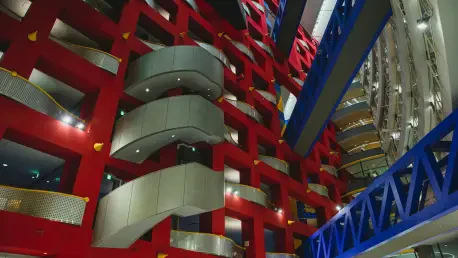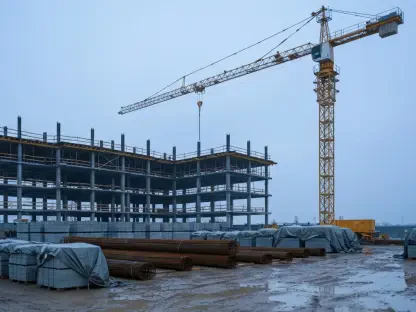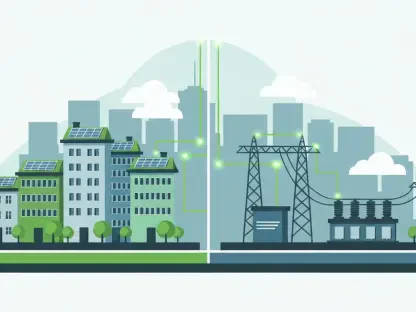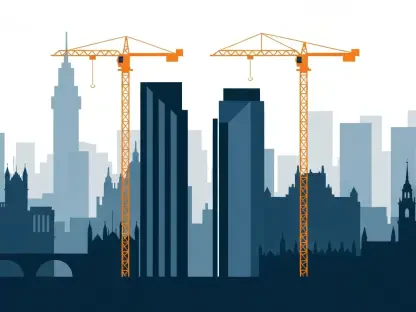Luca Calarailli has established a formidable reputation in the realms of construction, design, and architecture. With a keen interest in the intersection of these disciplines with emerging technologies, he has led groundbreaking projects that blend innovation with practical application. We are diving into the specifics of the I-76 Trade Center project, a significant milestone in his career, to explore the challenges and achievements involved.
Can you tell us about the completion of the first phase of the I-76 Trade Center project? What were some of the key features of this phase?
Absolutely. The first phase of the I-76 Trade Center marks a significant achievement, involving the construction of a 636,121-square-foot Class A logistics facility. Designed to cater comprehensively to industrial needs, this building features a remarkable 40-foot clear height, 108 loading docks, and four drive-in doors. Furthermore, we provided ample parking space with 146 trailer and 508 car parking slots. What stands out is not just the facility itself, but its role as a catalyst in a larger transformative development in this region.
What were some of the challenges faced during the construction of this large-scale logistics facility, and how did you overcome these obstacles?
One of the primary challenges was managing the logistics of such a sizable facility within the given environmental and regulatory constraints. We had to coordinate effectively between various teams while also ensuring compliance with local and state guidelines. Overcoming these hurdles required proactive planning and agile problem-solving approaches, especially with any unexpected developments. Collaborative efforts across the board enabled us to stay on schedule and deliver a quality product.
What role did KSS Architects and Alston play in this project? Could you describe their collaboration with Portman Holdings?
KSS Architects took on the pivotal role of designing the development, bringing their expertise in creating functional yet visually appealing spaces. Alston, as the general contractor, executed the construction with precision and skill. Our collaboration was seamless, with open communication channels ensuring that every party was aligned with the project’s vision and objectives. This cohesive teamwork was instrumental in bringing the project to life efficiently and effectively.
How did Bank OZK contribute to the project, and what impact did the $60 million construction note have on your project?
Bank OZK was essential in financially enabling the project, providing a $60 million construction note that was crucial for our capital flow. This financial backing allowed us to maintain momentum through various stages of development without encountering significant fiscal roadblocks. The note was a linchpin for ensuring that resources were available when needed, facilitating a smooth construction phase.
Could you elaborate on the location of the facility and its significance? How does its proximity to major infrastructure add value to the project?
The facility’s location at 1130 Pottstown Pike in Exton, Pennsylvania, greatly enhances its appeal and operational efficiency. Being just 37 miles from downtown Philadelphia, and close to the port and airport, positions the site as an ideal logistics hub. Its proximity to major arteries like Interstate 76 and U.S. Route 30 offers excellent connectivity for transportation and distribution. These advantages make the Trade Center a critical node for regional and national trade operations.
What role does Happy Days Park play in the I-76 Trade Center, and how does the park contribute to the overall development?
Happy Days Park is a vital piece of our vision for the Trade Center, adding a balance of commerce and greenspace. This 36-acre park provides not only recreational benefits but also preserves a sense of historical context with its farm structures. Such elements enhance the community’s quality of life and attract businesses that value a holistic environment for their employees.
What are your plans for the second phase of the I-76 Trade Center?
The upcoming phase promises to propel the Trade Center into greater prominence. We are looking to break ground shortly, expanding with two new facilities totaling over 1.2 million square feet. This second phase will stress sustainability and modern industrial requirements, ultimately reinforcing the site as a premier industrial area. We’re targeting to commence construction soon, optimizing timing and impact in line with market demands.
How does this project fit into Portman Holdings’ broader strategy in the industrial market? How has your industrial footprint grown since entering the sector in 2021?
Strategically, the I-76 Trade Center represents our commitment to leadership in industrial development. Since entering the market in 2021, our footprint has expanded to 8.8 million square feet of products that are either completed, in progress, or planned. This growth trajectory reflects our focus on high-efficiency facilities and strategic geographic positioning in key markets.
Can you discuss Portman’s other industrial ventures, like the Summerville Logistics Center in South Carolina? How might these projects influence future projects or strategies?
The Summerville Logistics Center, developed in partnership with CapitaLand Ascendas REIT, underlines our approach to collaboration and strategic location selection. Such projects are pointers to our future endeavors, guiding our strategies toward integrating technological advancements and enhancing operational efficiency. They provide a template for quality and collaboration that we’ll likely replicate as we expand our industrial portfolio.
How does Greater Philadelphia’s industrial market compare to national trends? What factors contribute to its above-average growth and completions?
The Greater Philadelphia market’s resilience is noteworthy, highlighted by its above-national-average growth metrics. Contributing factors include strategic location advantages, a robust transportation network, and a supportive business environment. These elements collectively ensure steady demand and development, positioning the area as a critical player in the national industrial market.
What strategies might Portman Holdings employ to address the current industrial vacancy rate in metro Philadelphia?
Addressing vacancy rates involves understanding market dynamics and tenant needs. We focus on flexible and sustainable facility designs, attracting diverse tenants with varying space requirements. Comparing to the national averages, our strategy includes promoting occupancy through value-added amenities and robust infrastructure, making our developments not just spaces, but sought-after destinations.
Do you have any advice for our readers?
Recognize the evolving trends within construction and real estate development. Embracing innovation and sustainability is key. Whether you’re a developer, designer, or investor, understanding the broader market landscape and the technological tools at your disposal can make a significant difference in creating impactful projects.









